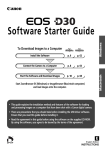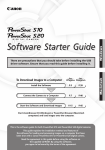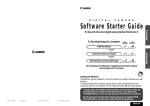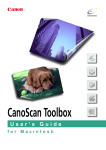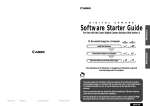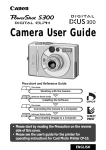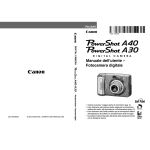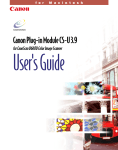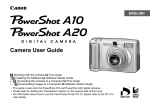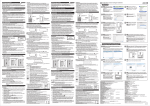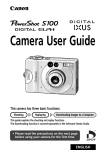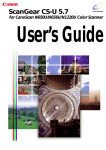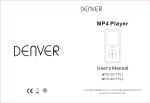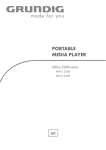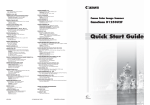Download Canon S100 Software Starter Guide
Transcript
1 NEITHER CANON NOR ANY OF CANON’S SUBSIDIARIES, DISTRIBUTORS OR DEALERS IS LIABLE FOR ANY DAMAGES HOWSOEVER CAUSED, INCLUDING WITHOUT LIMITATION, DIRECT, CONSEQUENTIAL OR INCIDENTAL LOSS OR DAMAGE INCLUDING LOSS OF PROFITS, EXPENSE OR INCONVENIENCE HOWSOEVER CAUSED OR ARISING OUT OF THE SOFTWARE OR THE USE THEREOF. NEITHER CANON, NOR ANY OF CANON’S SUBSIDIARIES, DISTRIBUTORS OR DEALERS SHALL HAVE ANY OBLIGATION TO INDEMNIFY YOU AGAINST ANY CLAIM OR SUIT BROUGHT BY A THIRD PARTY ALLEGING THAT THE SOFTWARE OR THE USE THEREOF INFRINGES ANY INTELLECTUAL PROPERTY OF SUCH THIRD PARTY. 5. TERM: This Agreement is effective upon your using the SOFTWARE and remains in effect until expiration of all copyright interests in the SOFTWARE unless earlier terminated. You may terminate this Agreement by destroying the SOFTWARE. This Agreement will also terminate without notice to you if you fail to comply with any of the terms of this Agreement and you must then promptly return the SOFTWARE. In addition, Canon may enforce its other legal rights. 6. U.S. GOVERNMENT RESTRICTED RIGHTS NOTICE: The SOFTWARE is provided with restricted rights. Use, duplication or disclosure is subject to restrictions as set forth in either subparagraph (c) (1) (ii) of the Rights in Technical Data and Computer software clause at DFARs 252.227-7013 or subparagraph (c) (1) and (2) of the Commercial Computer Software Restricted Rights Clause at FAR 52.227-19, as applicable. 7. SEVERABILITY: In the event that any provision of this Agreement is declared or found to be illegal by any court or tribunal of competent jurisdiction, such provision shall be null and void with respect to the jurisdiction of that court or tribunal and all the remaining provisions of this Agreement shall remain in full force and effect. 8. CONTROLLING LAW: The terms of this Agreement as it relates to purchases of the Software in the United States of America shall be governed and construed in all respects in accordance with the laws and regulations of the State of New York, without reference to choice of law principles. The terms of this Agreement as it relates to purchases of the Software in Canada shall be governed by the laws of the province of Ontario. 9. OWNERSHIP: All rights, including but not limited to copyrights and trade secret rights, to the SOFTWARE belong to Canon, its affiliated corporations and third party licensors. Your use of the SOFTWARE is subject to the United States, Canada and other applicable copyright and trademark laws and nothing in this Agreement constitutes a waiver of the rights of Canon, its affiliated corporations and third party licensors under such laws. Nothing contained in Paragraph 1 shall be construed to give Canon any ownership rights in any images, graphics or textual material that you save in connection with the Software. 10. ACKNOWLEDGEMENT: BY USING THE SOFTWARE, YOU ACKNOWLEDGE THAT YOU HAVE READ THIS AGREEMENT, UNDERSTOOD IT, AND AGREE TO BE BOUND BY ITS TERMS AND CONDITIONS. YOU ALSO AGREE THAT THIS AGREEMENT IS THE COMPLETE AND EXCLUSIVE STATEMENT OF AGREEMENT BETWEEN YOU AND CANON CONCERNING THE SUBJECT MATTER HEREOF AND SUPERSEDES ALL PROPOSALS OR PRIOR AGREEMENTS, VERBAL OR WRITTEN, AND ANY OTHER COMMUNICATIONS BETWEEN THE PARTIES RELATING TO THE SUBJECT MATTER HEREOF. NO AMENDMENT TO THIS AGREEMENT SHALL BE EFFECTIVE UNLESS SIGNED BY A DULY AUTHORIZED OFFICER OF CANON. 2 Introduction Thank you for purchasing a Canon digital camera. This guide explains the software used with the following models. • • • • PowerShot S100 DIGITAL ELPH DIGITAL IXUS PowerShot S10 PowerShot S20 Note • The serial port interface is only supported by the PowerShot S10 and PowerShot S20 models. Disclaimer • While every effort has been made to ensure that the information contained in this guide is accurate and complete, no liability can be accepted for any errors or omissions. Canon Inc. reserves the right to change the specifications of the hardware and software described herein at any time without prior notice. • No part of this guide may be reproduced, transmitted, transcribed, stored in a retrieval system, or translated into any language in any form, by any means, without the prior written permission of Canon Inc. • Canon Inc. makes no warranties for damages resulting from corrupted or lost data due to a mistaken operation or malfunction of the camera, the software, the CompactFlash™ cards (CF cards), personal computers, peripheral devices, or use of non-Canon CF cards. Trademark Acknowledgments • • • • • • Canon and PowerShot are trademarks of Canon Inc. Adobe, Adobe PhotoDeluxe and Photoshop are trademarks of Adobe Systems Incorporated. CompactFlash is a trademark of SanDisk Corporation. IBM is a registered trademark of International Business Machines Corporation. iBook and iMac are trademarks of Apple Computer, Inc. Macintosh, PowerBook, Power Macintosh and QuickTime are trademarks of Apple Computer Inc., registered in the United States and other countries. • Microsoft, Windows and Windows NT are either registered trademarks or trademarks of Microsoft Corporation in the United States and/or other countries. • Other names and products not mentioned above may be registered trademarks or trademarks of their respective companies. Copyright © 2000 Canon Inc. All rights reserved. 3 Using the Software on the Windows Platform Introducing the Software .............................................................. 4 Installing/Uninstalling the Software ............................................ 7 Connecting the Camera to a Computer ........................................ 9 Selecting a Connection Method ............................................. 9 Connecting to a USB Port ...................................................... 11 Installing the USB Driver ........................................................ 13 Connecting via a CF Card Reader or PC Card Slot ................. 19 Connecting to a Serial Port (COM Port) ................................. 20 From Loading to Printing ............................................................ 21 Basic Procedures for Using ZoomBrowser EX ............................. 28 Displaying Images .................................................................. 28 Organizing Images ................................................................. 32 Erasing Images ....................................................................... 33 Saving Computer Images to a CF Card in the Camera ........... 34 Editing Camera Slide Shows ................................................... 34 Stitching Panoramas Together with PhotoStitch ................... 35 Editing and Applying Special Effects to Images .................... 36 Sending Images via E-mail ..................................................... 36 Printing Images ...................................................................... 37 Backing Up Data .................................................................... 40 Loading Images with TWAIN-Compliant Application Programs (Adobe PhotoDeluxe, Adobe Photoshop, etc.) ........................ 41 Troubleshooting the USB Driver Installation .............................. 44 Troubleshooting the Computer Connection ............................... 81 Customer Support ....................................................................... 83 Windows System Requirements ................................................................... 6 4 Introducing the Software This section introduces the powerful software programs for the Windows platform contained on the CD-ROMs included with the camera. Canon Digital Camera Solution Disk ZoomBrowser EX To load camera images, start ZoomBrowser EX. Camera Connection Functions • • • • • (Also effective for CF card readers or PC card readers) Displays camera images. Downloads camera images to the computer. Saves computer images to a CF card in the camera. Edits slide shows for replay by the camera (PowerShot S10/S20 models only). Connecting to a USB port automatically starts ZoomBrowser EX and displays the camera images. Image File Management Functions • Displays, moves, copies or deletes images stored on computer disks. • Allows simple editing procedures, such as image color adjustments and cropping. • Displays all the files in a specified folder at once and zooms them in and out to facilitate visual searches. • Displays files in chronological order in a window that looks like a time tunnel. • Replays images from the computer one-by-one at full screen size to simulate a slide show. Image Printing Functions • Prints multiple images on the same page using the PhotoRecord printing utility. • Performs auto layouts. • Allows you to effortlessly place frames or backgrounds around your images for artistic effect. • Allows you to place titles or captions anywhere on the page . • Lets you create your own exclusive albums. Supports PhotoStitch Panoramas • Allows you to select camera images or images registered with ZoomBrowser EX and start PhotoStitch from within ZoomBrowser EX to merge a series of images into a panorama in a few simple steps. 5 Supports the Adobe PhotoDeluxe Photo Retouching Program • Starts this photo-retouching program to edit and apply special effects to your images. Adobe PhotoDeluxe Home Edition can be installed from the Adobe PhotoDeluxe CD-ROM. Starts Your E-mail Program • Starts your e-mail program and prepares images as e-mail attachments. • Allows you to adjust the image size and quality to reduce file sizes for transmission. • Automatically arranges images shot in Stitch Assist mode into the correct order and effortlessly merges them. • Merges any number of images horizontally or vertically, or in a matrix format. • Makes images with straight lines appear natural not crooked when merged. (Select the Wide display format.) • A 360-degree scene shot in several frames can be merged into a 360-degree image and saved in the QuickTime VR format, making it appear as if you were standing in the middle of the image looking about in all directions. TWAIN Drivers Canon Digital Camera USB TWAIN Driver Canon Digital Camera RS-232C TWAIN Driver These are the driver utility programs that work within TWAIN-compliant application programs, such as Adobe PhotoDeluxe Home Edition and Photoshop, to load camera images directly into the application program. The USB TWAIN Driver is for use when the camera is connected via the USB interface. The RS-232C TWAIN Driver is for use when the camera is connected via a serial (COM) port. Neither TWAIN driver can be used as a stand-alone software program. Adobe PhotoDeluxe CD-ROM Adobe PhotoDeluxe Home Edition • Allows you to edit images and effortlessly create greeting cards, birthday cards and calendars. Windows PhotoStitch 6 System Requirements The following system requirements must be met to install and operate the software. = Computer Model IBM PC/AT compatible = OS Windows 95, Windows 98 (Including the Second Edition), Windows NT 4.0 (Service Pack 3 or higher required) or Windows 2000 = CPU Pentium 133 MHz or better = RAM 32 MB or more (Windows 95/98) 64 MB or more (Windows NT 4.0/Windows 2000) = Interface USB (Limited to pre-installed Windows 98 or Windows 2000 systems) RS-232C (Serial/COM port for PowerShot S10/S20 models only) = Free Hard Disk Space Canon Utilities ZoomBrowser EX: 120 MB or more (Including the PhotoRecord printing utility) PhotoStitch: 40 MB or more Canon Digital Camera USB TWAIN Driver: 15 MB or more Canon Digital Camera RS-232C TWAIN Driver: 15 MB or more Adobe PhotoDeluxe Home Edition: 140 MB or more (Works with the Windows 95/98/NT 4.0 operating systems) = Display Minimum: 800 x 600 pixels, 256 colors Recommended: 1,024 x 768 pixels, High Color (16 bit) or more • A CD-ROM drive is required to install the software. • QuickTime 3.0 or higher is required to save PhotoStitch output in the QuickTime VR format. 7 Installing/Uninstalling the Software Installing from the Canon Digital Camera Solution Disk 1. Close any programs that are running. 2. Place the Canon Digital Camera Solution Disk in the CD-ROM drive. The installer panel will automatically display. • If the installer panel does not automatically display, use the following procedures to start it. 1. Double-click the [My Computer] icon on the desktop, and double-click the CD-ROM icon in the next window. 2. Double-click the [Setup] icon. 3. Click [Software Installation]. 4. Select the install location and click the [Next] button. 5. Select the software you wish to install and follow the on-screen instructions to proceed. 6. Click the [Finish] button when the installation is complete and the installer panel appears again. Windows If you are installing the software onto Windows NT 4.0 or Windows 2000, you must first log on as the administrator and then install the software. 8 Installing from the Adobe PhotoDeluxe CD-ROM For installation instructions, place the Adobe PhotoDeluxe CD-ROM in the drive and click [ReadMe & Guide] and [Install Guide] in the window that displays. The serial number shown during installation will be required for the user registration process. If You Will Be Connecting via a USB Port You must install a separate USB driver. Please see page 13 for instructions. Uninstalling the Software To remove the installed software, click the Windows [Start] menu and select [Settings], [Control Panel] and [Add/Remove Programs]. ZoomBrowser EX can also be uninstalled by clicking the [Start] menu and selecting [Programs], [Canon Utilities], [ZoomBrowser EX], and [Uninstall ZoomBrowser EX]. (PhotoRecord and PhotoStitch can be removed with the same procedures.) 9 Connecting the Camera to a Computer Selecting a Connection Method The following different interfaces and methods can be used to connect the camera to a computer. Once a connection has been established using one of the methods, you can start the software and begin to load the camera images (➜ p. 21 or 41). • You are recommended to use the AC adapter while the camera is connected to a computer to conserve the battery charge. USB Port (➜ p. 11) The USB interface transfers data more rapidly than the serial interface and can start the image loading software automatically. USB Cable Connector Shapes Camera End Computer USB Port Computer End The USB port is marked with this symbol. CF Card Reader or PC Card Slot (➜ p. 19) If you have a computer equipped with a PC card slot, a CF card reader or a PC card reader, you can place the camera’s CF card into these devices to establish a direct connection. You will require a PC card adapter for PC card slots. CF Card Windows Use the AC Adapter 10 Serial Port (COM Port) (➜ p. 20) The serial interface is supported by the PowerShot S10 and PowerShot S20 models only. Serial Cable Connector Shapes Camera End Computer End Computer Serial Port The serial port is marked with this symbol. 11 Connecting to a USB Port • The USB interface can only be used to connect the camera to computers with Windows 98 or Windows 2000 preinstalled (clean installation). The USB ports on computers running versions of Windows 98 or Windows 2000 upgraded from Windows 3.1 or Windows 95, or versions of Windows 2000 upgraded from Windows 98 may not operate correctly. • Connect the USB cable directly to one of the computer’s main USB ports. The interface may not function correctly if the camera is connected via a USB hub. • The interface may not function correctly while other USB devices, excluding USB mice and keyboards, are connected. If this problem arises, detach the camera and the other devices, and reconnect the camera only. • Do not attach more than one camera to the USB ports of the same computer at the same time. The cameras may not operate correctly. Important • Please do not place your computer into standby mode while the camera is connected to its USB port. If you place the computer into standby mode while the camera is connected to a USB port, do NOT disconnect the USB cable from the camera or computer. Try to revive the computer. If the USB cable is detached in standby mode, some computers may not return to active mode correctly. For instructions regarding the standby mode, please consult the manual accompanying your computer and operating software. Windows Requirements for the USB Interface 12 1. Attach the supplied USB cable to a USB port directly on the computer and to the DIGITAL terminal on the camera as shown below. • There is no need to turn the camera or computer power off when attaching or detaching the USB cables. • Please consult your computer’s manual for the location of the USB ports. USB Port USB Connector USB Connector DIGITAL Terminal 1. Open the DIGITAL terminal cover by slipping a fingernail under the top edge and pulling down. 2. Insert the connector so that the4marks on the connector and camera align. 2. Install the USB driver the first time you connect via a USB port. (➜ p. 13) Precaution for Unplugging Cables from the DIGITAL Terminal • Always press the [PUSH] button on the connector to detach the cable from the camera’s DIGITAL terminal. PUSH Button 13 Installing the USB Driver (Preinstalled Windows 98/2000 Systems Only) • The USB driver only needs to be installed the first time the camera is connected via the USB interface. Installation is not required from the second time onward. • Do not cancel the installation partway through. Allow the procedure to finish completely before exiting. The camera may not operate correctly if the installation is incomplete. • Read the Troubleshooting the Driver Software Installation section on page 44 if the installation cancels itself during the procedure, if the installation does not proceed as described in these procedures, or if you think that the drivers are not properly installed. • Read the “Uninstalling the USB Driver” section on page 44 for instructions for that procedure. Installing the USB Driver into Windows 98 Windows 98 CD-ROM • Your computer may prompt you to insert the CD-ROM containing your Windows system software during the installation. Have the Windows disk handy in case it is required. 1. Once you have attached the USB cable to the camera and computer, set the camera to the mode for communicating with a computer. (➜ p. 12) • PowerShot S100 DIGITAL ELPH/DIGITAL IXUS Slide the mode switch to the position and press the main switch to turn on the power. • PowerShot S10/S20 Turn the mode dial to the position. The “Add New Hardware Wizard” dialog will appear after a moment. 2. Read the dialog and click the [Next] button. Your camera model name will appear here. The dialog will change to the search selection dialog. Windows Notes Regarding Installation 14 3. Select [Search for the best driver for your device (recommended)] and click the [Next] button. The dialog will change to the one that allows you to specify the search location. 4. Place the Canon Digital Camera Solution Disk in the CD-ROM drive. 5. Confirm that the [CD-ROM drive] option is selected in the dialog and click the [Next] button. The dialog will change to the one that states it is searching for the driver files. 6. Read the dialog and click the [Next] button. Your camera model name will appear here. 15 The computer will start to copy the driver files from the CD-ROM. When all the required files have been copied, the dialog will state that the installation is complete. What to Do if You Are Prompted for the Windows System Disk during the Driver File Copying Process • If prompted for the Windows system disk, replace the Canon Digital Camera Solution Disk with it and follow the on-screen instructions. If a dialog states that the “usbscan.sys” cannot be found, click the [Browse] button and specify the location as the [WIN98] folder on the Windows system disk. 7. Read the dialog and click the [Finish] button. Your camera model name will appear here. An event dialog for your camera model will display to allow you to select application programs. (➜ p. 21, Step 2, or p. 41, Step 2.) • If a dialog prompts you to restart your computer, remove the CD-ROM from the drive and restart the computer as instructed. Windows Do NOT cancel the copy operation while it is in progress. 16 Installing the USB Driver into Windows 2000 Begin by logging onto the computer as the Administrator and then install the USB driver. 1. Once you have attached the USB cable to the camera and computer, set the camera to the mode for communicating with a computer. (➜ p. 12) • PowerShot S100 DIGITAL ELPH/DIGITAL IXUS Slide the mode switch to the position and press the main switch to turn on the power. • PowerShot S10/S20 Turn the mode dial to the position. The “Add New Hardware Wizard” dialog will appear after a moment. 2. Read the dialog and click the [Next] button. 3. Select [Search for a suitable driver for my device (recommended)] and click the [Next] button. Your camera model name will appear here. The dialog will change to the one that allows you to specify the search location. 4. Place the Canon Digital Camera Solution Disk in the CD-ROM drive. 17 5. Confirm that the [CD-ROM drives] option is selected in the dialog and click the [Next] button. The dialog will change to the one that states it is searching for the driver files. 6. Read the dialog and click the [Next] button. Your camera model name will appear here. 7. Click the [Yes] button if the “Digital Signature Not Found” message displays. Your camera model name will appear here. Windows Your camera model name will appear here. 18 8. Click [No to All] if the “Confirm File Replace” dialog displays. 9. Read the dialog and click the [Finish] button. Your camera model name will appear here. An event dialog for your camera model will display to allow you to select application programs. (➜ p. 21, Step 2 or p. 41, Step 2.) • If a dialog prompts you to restart your computer, remove the CD-ROM from the drive and restart the computer as instructed. 19 Connecting via a CF Card Reader or PC Card Slot To load images directly from a CF card to a computer, eject the card from the camera, place it in a separately sold PC card adapter (PCMCIA card adapter) and insert the assembly into the PC card slot. The adapter is not required if your computer is equipped with a CF card reader. Place the CF card directly into the reader. Place the CF card in the PC card adapter. Windows 1. Place the CF Card in the Adapter. 2. Insert the loaded PC card adapter into the computer’s slot or PC card reader. The requirements for the power being on or off when the PC card adapter is inserted differ according to the product. Please consult the manuals accompanying your equipment. Insert the Adapter in the Slot. 20 Connecting to a Serial Port (COM Port) The serial port interface is only supported by the PowerShot S10 and PowerShot S20 models. 1. Shut down the computer and turn the camera power off. 2. Attach the supplied serial cable to a serial port on the computer and to the camera’s DIGITAL terminal as shown below. • Please consult your computer’s manual for the location of the serial port. Serial Port (COM Port) Serial Connector Serial Connector DIGITAL Terminal 1. Open the DIGITAL terminal cover by slipping a fingernail under the top edge and pulling down. 2. Insert the connector so that the4marks on the connector and camera align. 3. Turn on the computer and start Windows. Precaution for Unplugging Cables from the DIGITAL Terminal • Always press the [PUSH] button on the connector to detach the cable from the camera’s DIGITAL terminal. PUSH Button 21 From Loading to Printing This section provides a simple explanation of the procedures for using ZoomBrowser EX to load and print images. Please refer to the ZoomBrowser EX Help file for more details. • If approximately five minutes pass without a camera function being accessed when the camera is connected via the USB interface, a message on the computer display will ask if you wish to remain connected. If you do not access a function, the camera will close the connection after an additional minute passes. Use the procedure below to reconnect. • PowerShot S100 DIGITAL ELPH/DIGITAL IXUS Press the camera’s main switch. • PowerShot S10/S20 Press the camera’s shutter button. (The dialog will not appear and the camera will not close the connection if the camera is being powered by the AC adapter.) Starting ZoomBrowser EX USB Interface 1. Attach the camera to the computer with the USB cable. (➜ p. 12) 2. Set the camera to the mode for communicating with a computer. • PowerShot S100 DIGITAL ELPH/DIGITAL IXUS Slide the mode switch to the position and press the main switch to turn on the power. • PowerShot S10/S20 Turn the mode dial to the position. An application selection dialog will display. Your camera model name will appear here. 3. Select [Canon ZoomBrowser EX] and click the [OK] button. ZoomBrowser EX will start and display the camera’s images as small thumbnail images in the ZoomBrowser EX Camera Window. (➜ p. 24) Windows What to Do if the “Caution! Connection Time” Dialog Displays 22 How to Have ZoomBrowser EX Start Automatically • If you want ZoomBrowser EX to start automatically without first displaying the event dialog, use the procedures below to change the settings. 1. Open the [My Computer] window while the camera is connected to the computer via the USB interface. 2. Open the [Control Panel] and select [Scanners and Cameras] and your camera model. 3. Click the [Properties] button and display the [Events] tab. 4. A list of applications registered for automatic starting will display. Remove the checks beside every program except for ZoomBrowser EX. Click the [OK] button. • ZoomBrowser EX will now start automatically the next time you connect the camera. If the [Disable device events] option has a check mark, the automatic start will be turned off. CF Card Reader or PC Card Slot Interface 1. Place the CF card into the CF card reader or into the PC card adapter and then into the PC card slot. (➜ p. 19) 2. Start ZoomBrowser EX. Double-click the [Canon ZoomBrowser EX] icon on the desktop to start the program. Canon ZoomBrowser EX Icon If the [Canon ZoomBrowser EX] icon does not appear on the desktop, click the Windows [Start] button and select [Programs], [Canon Utilities], [ZoomBrowser EX] and [ZoomBrowser EX]. Quick Tips will automatically display. Read these tips to quickly understand operating procedures. 3. Click the [IMPORT IMAGES] button and select [From Dcim]. The images from the CF card will display in ZoomBrowser EX Camera Window as small thumbnail images. (➜ p. 24) 23 Serial Interface 1. Attach the camera to the computer with the serial cable. (➜ p. 20) 2. Turn the camera’s mode dial to the 3. Start ZoomBrowser EX. Double-click the [Canon ZoomBrowser EX] icon on the desktop to start the program. Canon ZoomBrowser EX Icon If the [Canon ZoomBrowser EX] icon does not appear on the desktop, click the Windows [Start] button and select [Programs], [Canon Utilities], [ZoomBrowser EX] and [ZoomBrowser EX]. Quick Tips will automatically display. Read these tips to quickly understand operating procedures. 4. Click the [IMPORT IMAGES] button and select [From Camera]. The camera’s images will display as small thumbnail images in the ZoomBrowser EX Camera Window. (➜ p. 24) Windows position. 24 The ZoomBrowser EX Camera Window The Camera Window will open when a connection to a camera or CF card is initiated. Thumbnail (small) images will display. An image of the connected camera or CF card will display. Thumbnail SETUP OPTIONS Button DELETE Button EDIT SLIDESHOW Button Sets various camera settings (see inset below) using the computer. Deletes the selected images. Edits slide shows from the camera. (➜ p. 34) DOWNLOAD Button Copies selected images to the computer from the camera or CF card. (➜ p. 25) UPLOAD Button Copies images from the computer to the camera or CF card. (➜ p. 34) How to Check and Change Various Camera Settings • You can adjust the date, time and owner settings in the “Camera Settings” dialog using the computer when the camera is connected. You can also check the battery charge and remaining memory capacity. 1. Click the [SETUP OPTIONS] button. 2. Check or change the settings. Input a camera owner name here. (up to 31 characters) Set the date and time. Click this button to synchronize the camera to the computer’s date and time settings. Check the battery charge here. Check the remaining memory capacity here. 25 Loading and Saving Images from the Camera 1. Create a new folder in which to save the images from the camera. In the Tree View, right-click the [Image Library One] folder, select [New Folder] from the pop-up menu and input a folder name. 2. Select the new folder in the Tree View. 3. Select the images that you wish to download from the Camera Window and click the [DOWNLOAD] button. Click the thumbnail you wish to select or press [Ctrl] and click to select multiple thumbnails. Thumbnail The downloaded images will be saved to the computer disk and appear in the Browser Display Area. Windows Tree View 26 • You can also download images to the computer by dragging them from the Camera Window and dropping them on the Browser Display Area or Tree View. Browser Display Area Tree View To disconnect the camera, click the close box Window. The Camera Window will close. at the upper right of the Camera 27 Printing Images Select the image(s) you wish to print and click the [PRINT] button. The PhotoRecord printing utility will start and automatically display the selected image(s) in a page layout. 2. Adjust the print settings if you wish to change the page layout. Please refer to page 37 or the PhotoRecord Help file for details of the settings. 3. Click the PhotoRecord [PRINT] button. The “Print” dialog will display. 4. Click the [OK] button to start printing. Windows 1. 28 Basic Procedures for Using ZoomBrowser EX This section provides a simple explanation of the basic procedures for using ZoomBrowser EX. Please refer to the ZoomBrowser EX Help file for more details. Displaying Images Zooming Images In and Out (a) Double-Clicking the Browser Display Area Double-click the background frame of the folder in which an image is registered to zoom it to fill the Browser Display Area. Browser Display Area Double-click the background frame of the folder. Click this button to go back to a folder one level higher. (b) Selecting a Folder in the Tree View You can also zoom a folder in or out with its icon selected in the Tree View. Click a higher level folder to zoom out. Click a lower level folder to zoom in. 29 Zooming a Single Image Double-click the target image. Edit Panel Button About the Image Viewer Edit Panel • The edit panel displays when you click Edit Panel button in the Image Viewer. CROP Button Drag the cursor to select the crop area and click the [CROP] button to trim everything outside the crop area. SAVE AS Button Save the image with a different name and file format. COLOR/BRIGHTNESS/CONTRAST Sliders Slide the tab to adjust the color, brightness or contrast settings. UNDO/REDO Buttons Reverse an action or reimplement it. Windows Double-click an image in the Browser Display Area to display it in the Image Viewer. 30 Displaying Images in Chronological Order Select a folder or some images, click the [View] menu and select [TimeTunnel]. The selected image(s) will display in a time tunnel. Please refer to the TimeTunnel Help file for more details on how to operate this function. Drag the tab up or down to go backward or forward in time. The time tunnel will advance in the selected direction. To quit TimeTunnel and return to the ZoomBrowser EX window, click this button. Showing Images in a Slide Show The slide show function displays images saved onto the computer disk one-by-one at full-screen size as if they were part of a slide show. 1. Click the [View] menu and select [Slide Show Options]. 2. Select a play method. The “Slide Show Options” dialog will display. Set a play interval and a transition effect and click the [OK] button. 3. Select images from the ZoomBrowser EX Browser Display Area for showing. 4. Click the [View] menu and select [Slide Show]. The selected images will play in order. The slide show will close after the last image is displayed. If the slide show is set to repeat, press the on the control panel to close the slide show. 31 About the Print Mark Button • A print mark can be added to an image by clicking the [Print Mark] button when it is displayed in a slide show. • PhotoRecord will automatically start at the end of the slide show and place the marked images in an auto layout. Windows • Please refer to page 37 or the PhotoRecord Help file for more details on how to operate this function. Print Mark Button 32 Organizing Images Changing the File Location You can move an image file by dragging and dropping it onto another folder icon. Drag an image from the Browser Display Area to another folder in the Tree View. Browser Display Area You can also drag and drop images within the Browser Display Area. Tree View The [Image Library One] folder is located within the folder in which ZoomBrowser EX was installed. The Tree View displays files at levels below this folder. Adding a New Library Folder Adding a folder to the Tree View allows you to display the images in that folder and its subfolders in ZoomBrowser EX. Click the [File] menu, select [Add Image Library] and select the folder. The selected folder will appear in the ZoomBrowser EX Tree View as a new library. Refreshing the Contents of a Library If you have used another program, such as the Windows Explorer utility or Adobe PhotoDeluxe Home Edition, to move or edit images that are registered with ZoomBrowser EX, you should select the library, click the [View] menu and select [Refresh Current Library]. This will update the library. 33 Erasing Images An image cannot be recovered after it is erased. Double-check to make sure you have the right images before erasing. 1. Select the target image in the Browser Display Area and click the [DELETE] button. A confirmation dialog will display. 2. Check the image to make sure it can be deleted and click [Delete]. The image will be erased. Erasing Images by Folder 1. Click the background frame of the target folder and the [DELETE] button. A confirmation dialog will display. 2. Check the images to make sure they can be deleted and click [Delete]. The images and the folder will be erased. Browser Display Area Click images singly to erase them. Click on the folder’s background frame to erase the folder and all its images. Tree View DELETE Button Windows Erasing Images Singly 34 Saving Computer Images to a CF Card in the Camera 1. Open the Camera Window. (➜ pp. 21-23) 2. Click the [UPLOAD] button in the Camera Window. The “Upload Images from Disk” dialog will display. 3. Select the images from the computer and click the [Open] button. The “Save to Camera” dialog will display. 4. Select the image size and resizing options and click the [Save to Camera] button. The selected image will be saved onto the camera’s CF card. Editing Camera Slide Shows (PowerShot S10/S20 Only) This function allows you to edit slide shows played by the camera. To edit slide shows shown on the computer display, see “Showing Images in a Slide Show.” (➜ p. 30) 1. Open the Camera Window. (➜ pp. 21-23) 2. Click the [EDIT SLIDESHOW] button. The Edit Slide Show window will display. The camera images will display on the left side. Images registered in the selected slide show will display on the right side. Slide Shows 1 to 3 correspond to the numbers of the slide shows that can be shown with the camera. 3. Drag and drop images from the area on the left to the area on the right to register them in the slide show. You can drag images to change their order in the area on the right. This order corresponds to the replay order. 4. Click the [Save to Camera] button. The slide show will be saved to the CF card in the camera. 5. Click the [Exit] button on the toolbar. 35 Stitching Panoramas Together with PhotoStitch To Merge Images Registered in ZoomBrowser EX Follow the instructions to merge the images. Images Shot in Stitch Assist Mode • PhotoStitch automatically arranges images shot with the Stitch Assist mode of Canon digital cameras in the correct order and orientation, making it easy to merge these images. Stitch Assist mode images display in the Camera Window as shown below. Images shot in Stitch Assist mode have a green stitch mark. Click the stitch mark to start PhotoStitch and merge those images. Please see the Camera User Guide for instructions for shooting in Stitch Assist mode. Windows • You can merge a series of overlapping images into a single, seamless panorama. • Select the images in the browser area, click the [Edit] menu and select [PhotoStitch]. The PhotoStitch program will start. • Follow the instructions in the guidance window to merge the images. • Please refer to the PhotoStitch Help file for more details. 36 Editing and Applying Special Effects to Images 1. Confirm that the Adobe PhotoDeluxe Home Edition program has been installed. 2. Select an image from the Browser Display Area of ZoomBrowser EX. 3. Click the [Edit] menu and select [Edit Image using Adobe PhotoDeluxe Home Edition] Please refer to the Adobe PhotoDeluxe Home Edition Help file and electronic guide (Getting Started.pdf) for instructions for this program. 4. Edit and apply special effects to the image. • Once you have finished editing the image, click the [File] menu, select [Export] and [File Format], and save the image. • ZoomBrowser EX supports the BMP, FlashPix, JPEG and TIFF file formats. • If you selected a folder registered in ZoomBrowser EX as the save location, please return to the ZoomBrowser EX window, click the [View] menu and select [Refresh Current Library] to update the thumbnail in ZoomBrowser EX. Sending Images via E-mail You can send images as attachments to e-mail messages. You can adjust the image size and quality to reduce the file size for transmission. 1. Select the target image(s) in the Browser Display Area. 2. Click the [File] menu and select [Send Image(s) by E-Mail]. 3. Adjust the image size and quality. The e-mail image creation window will display. Set the image size and quality and follow the on-screen messages to complete the procedures. 4. Click the [Finish] button. When you click the [Finish] button, your e-mail program will start and open a new message with the image file attached. Input your message, a subject, the recipient’s address and send the message. Some e-mail programs or operating systems may not support the auto start function. In that case, temporarily save the adjusted image file to the desktop or another easy-to-find folder. Then start your e-mail program, open a new message and attach the adjusted image file to it. 37 Printing Images PhotoRecord Window Input titles or captions anywhere you wish. Click these buttons to select a layout pattern for each page. Click the arrow6 to display a pop-up menu. Drag the images to change the layout. Slide this tab to the left to shrink the image, right to expand it. Click this to stop importing images. Click this to display Help. Click this to redo the layouts for all pages. Click this to display the “Print” dialog. Click this to switch between auto and manual layout mode. Click this to change the background design or paper orientation. Click this to set the default number of images printed per page. Windows • Select a folder or image(s) for printing from the Browser Display Area or Camera Window and click the [PRINT] button to start the PhotoRecord program. • You can also click the button while an image is displayed in a slide show to add a print mark to it. When the slide show closes, PhotoRecord will start automatically. • The selected images will automatically display in a page layout. • Please refer to the PhotoRecord Help file for more details. 38 Creating a New Album The PhotoRecord layouts with titles and captions can be saved as albums. Moreover, PhotoRecord includes a variety of templates, making it easy to create beautiful albums. 1. To save an album, click the PhotoRecord [File] menu and select [Save As]. 2. Input a name and click [Save]. Add a title to the page Click the arrow 6 and select [Edit Title] from the pop-up menu. Add a caption to an image Right-click an image and select [Edit Caption] from the pop-up menu. Change the photo frame Right-click the image and select [Change Photo Frame] from the pop-up menu. Change the page background Right-click the page and select [Change Page Style] from the pop-up menu. Insert text Click the arrow 6 and select [Add Text] from the pop-up menu. Change the text box format Right-click a text box and select [Change Frame] from the pop-up menu. Image Resizing and Rotating Modes Image Resizing Mode Drag an arrow to resize the image. The arrows display when the mouse is positioned over the image. Click this to display a pop-up Click this to change to menu. rotating mode. Image Rotating Mode Drag an arrow to rotate the image. Click this to display a pop-up menu. Click this to change to image resizing mode. 39 Precaution when Printing from PhotoRecord from Windows NT 4.0/Windows 2000 • If the printer name is too long, you may not be able to print from PhotoRecord. Shorten the name to enable printing. Windows 1. Click the Windows [Start] menu and select [Settings] and [Printers]. 2. Click the printer name twice with a slight pause between clicks. Input a new name that is 31 characters or less. If the printer is a network printer, include the path name in the 31-character count. 40 Backing Up Data You are recommended to use the following procedures to back up your image data after you add, delete or change images from ZoomBrowser EX. 1. Click the ZoomBrowser EX [File] menu and select [Backup Database]. 2. Input a file name and click [Save]. The current database file will be saved with the specified name. The database file may become corrupted if a system crash occurs for some reason when ZoomBrowser EX is being run at the same time as another software program. You should restore the data in this case. To avoid unintentional loss, you should back up your image data frequently. How to Restore the Database File from a Backup File 1. Click the ZoomBrowser EX [File] menu and select [Open Database]. 2. Select the appropriate backup file. Confirm that the backup file has the [.zbd] file extension. 3. Click [Open]. This will restore the database file to the state from which it was backed up. 41 Loading Images with TWAIN-Compliant Application Programs (Adobe PhotoDeluxe, Adobe Photoshop, etc.) This section explains how to load images with TWAIN-compliant application programs using Adobe PhotoDeluxe Home Edition as an example. Please refer to the manual for each application program for more details. For installation instructions, place the Adobe PhotoDeluxe CD-ROM in the drive and click [ReadMe & Guide] and [Install Guide] in the window that displays. The serial number shown during installation will be required for the user registration process. Starting the Software USB Interface 1. Connect the camera to the computer’s USB port. (➜ p. 12) 2. Set the camera to the mode for communicating with a computer. • PowerShot S100 DIGITAL ELPH/DIGITAL IXUS Slide the mode switch to the position and press the main switch to turn on the power. • PowerShot S10/S20 Turn the mode dial to the position. An application selection dialog will display. 3. Select Adobe PhotoDeluxe Home Edition and click [OK]. Adobe PhotoDeluxe Home Edition will start and open the TWAIN driver. Use the TWAIN driver to load images. (➜ p. 43) Windows Installing from the Adobe PhotoDeluxe CD-ROM 42 CF Card Reader or PC Card Slot Interface 1. Place the CF card into the CF card reader or into the PC card adapter and then into the PC card slot. (➜ p. 19) 2. Start Adobe PhotoDeluxe Home Edition. 3. Click [Get & Fix Photo] at the upper left of the window. 4. Click [Get Photo] from the icons that display and select [Cameras]. 5. Click the [1 Camera] tab. In the [Camera Models] option, confirm that [Canon XXX USB] (XXX will be replaced by your camera model name) or [Canon Digital Camera RS-232C] is selected. If several models are listed, select the one that corresponds to your camera. 6. Click the [Open Camera] button. The TWAIN driver will start. Use it to load images. (➜ p. 43) Serial Interface 1. Attach the camera to the computer with the serial cable. (➜ p. 20) 2. Turn the camera’s mode dial to the 3. Start Adobe PhotoDeluxe Home Edition. 4. Click [Get & Fix Photo] at the upper left of the window. 5. Click [Get Photo] from the icons that display and select [Cameras]. 6. Click the [1 Camera] tab. In the [Camera Models] option, confirm that [Canon Digital Camera RS-232C] is selected. 7. Click the [Open Camera] button. The TWAIN driver will start. 8. Click the [Communication Settings] button. 9. Set the port type, port name and baud rate (transfer speed) settings and click the [OK] button. (➜ p. 43) For instructions on the communication settings, please refer to page 81. position. 43 1. Click the [Camera] button. To load images directly from a CF card outside the camera, click the [My Computer] button instead. The images from the camera or CF card will display in the thumbnail display area. 2. Select the images you wish to download and click the [Acquire] button. The images will appear in the Adobe PhotoDeluxe Home Edition window. 3. Click the [2 Done] tab in the Adobe PhotoDeluxe Home Edition window. Guide to the TWAIN Driver Window Rotate 90 Degrees Buttons Rotates the selected image left or right 90 degrees. Camera Settings Button Adjust or check camera settings. (➜ p. 24) Display Style Buttons Help Button Main Buttons Thumbnail Display Area These buttons control the main commands, such as those for loading images and exiting the TWAIN driver. Image thumbnails (small versions) display here when the camera is connected. Windows Loading the Camera Images 44 Troubleshooting the USB Driver Installation Check This First 1. Is the camera connected to the computer correctly? (➜ p. 12) 2. Is the camera power on? • PowerShot S100 DIGITAL ELPH/DIGITAL IXUS Slide the mode switch to and press the main switch to power up the camera. • PowerShot S10/S20 position. Turn the mode dial to the 3. Is the battery charge sufficient? You are recommended to use the AC adapter to power a camera connected to a computer. You will not be able to check the USB driver status if there is a problem with any of the items above. If the “Add New Hardware Wizard” (in Windows 2000 it is the “New Hardware Found Wizard”) appears while performing any of the steps above, reinstall the USB driver using the procedures in the Installing the USB Driver section. (➜ p. 13) If the three potential problems check out, first uninstall the USB driver with the procedures below before reinstalling it according to the instructions in the Installing the USB Driver section. (➜ p. 13) Uninstalling the USB Driver from Windows 98 Check the USB Driver Status • Does your camera model name appear in the Windows “Scanners and Cameras Properties” dialog? Display the “Scanners and Cameras Properties” dialog with the following steps. 1. Click the [Start] menu and select [Settings] and [Control Panel]. 2. Double-click the [Scanners and Cameras] icon. Check to see if your camera model appears here. The names of scanners and other devices for which drivers have already been installed will show in this window. 45 What to Do if Your Camera Model Name Is Not in the “Scanners and Cameras Properties” Device List or if the [Scanners and Cameras] Icon Is Not in the Control Panel Double-click the [System Properties] icon in the Control Panel and check the [Device Manager] tab. 2. Check the [Other devices] or [Imaging Devices] categories for an item corresponding to your camera model. Delete it with the following procedures. Windows 1. 1. Select the item corresponding to your camera model and click the [Remove] button. 2. Click the [OK] button in the confirmation dialog. 3. Click the [OK] button to close the “System Properties” dialog. Delete all copies if the item corresponding to your camera model appears in more than one category, such as the [Imaging Devices] and [Other Devices] categories, or if it is duplicated in the [Other Devices] category. 3. On the Windows desktop, double-click the [My Computer] icon, [C:] icon, [Windows] folder, and [Inf] folder in succession. 4 4 4 46 What to Do if the [Inf] Folder Is Not Visible in the [Windows] Folder • Follow the procedures below to set the folder options to the “Show all files” setting. 1. Click the [View] menu and select [Folder Options]. 2. Click the [View] tab. 3. In the [Hidden files] category, select [Show all files]. 4. Click the [OK] button to close the “Folder Options” dialog. This will show all the previously hidden files. 4. Find and delete the [Drvdata.bin] and [Drvdx.bin] files. The [Inf] folder contains numerous files. Ensure that you double-check the file names before you delete any files. Deleting the wrong file may, in the worst case scenario, result in the failure of your computer to run the Windows operating system. 5. Double-click the [Other] folder inside the [Inf] folder. 6. Find and delete the [Canon.IncCanon_DC] file. Skip this step if this file is not present in the [Other] folder. 47 What to Do if Your Camera Model Appears in the “Scanners and Cameras Properties” Device List 1. Select the name of your camera model and click the [Remove] button. 2. Click [OK] to close the “Scanners and Cameras Properties” dialog. 3. Delete the [Drvdata.bin], [Drvdx.bin] and [Canon.IncCanon_DC] files using steps 3 to 6 on pages 45 to 46. Uninstalling the USB Driver from Windows 2000 Begin by logging onto Windows 2000 as the Administrator and then start removing the USB driver. 1. Double-click the [Add/Remove Hardware] icon in the control panel. After the “Add/Remove Hardware Wizard” starts, click the [Next] button. Windows Your camera model name will appear here. 48 2. Select [Uninstall/Unplug Device] and click the [Next] button. 3. Select [Uninstall a Device] and click the [Next] button. 4. Select the name of your camera model from the list that displays and click the [Next] button Your camera model name will appear here. 49 5. In the dialog shown below, select [Yes, I want to uninstall this device] and click the [Next] button. Click the [Finish] button when the “Add/Remove Hardware Wizard complete” message displays. 6. On the desktop, double-click the [My Computer] icon, [C:] icon, [Winnt] folder, and [Inf] folder in succession. 4 4 4 What to Do if the [Inf] Folder Is Not Visible in the [Winnt] Folder 1. 2. 3. 4. Open the [Winnt] folder. Click the [Tools] menu and select [Folder Options]. Click the [View] tab. In the [Advanced Settings] category, find the [Hidden Files and Folders] subcategory and select [Show hidden files and folders]. 5. Click the [OK] button to close the “Folder Options” dialog. This will show all the previously hidden files and folders. Windows Your camera model name will appear here 50 7. Look for files starting with [Oem*]. A number such as 0 or 1 will appear in place of the “*”after the “Oem” prefix in the file name. For each [Oem*] file there is a companion [Oem*.pnf] file with the same number following the “Oem” prefix (e.g. the Oem0 and Oem.pnf files form one set of Oem files). • Please note that numerous groupings of “Oem” files may be present in the [Inf] folder. Do not delete the wrong files. 8. Search for the [Oem*] files for Canon digital cameras. Double-click a file to open it in the Windows Notepad accessory and look for [;*** Canon Digital Camera USB Setup File ****] in the first line. If you find it, note down the file name and close Notepad. 9. Delete the [Oem*] file and corresponding [Oem*.pnf] file. Ensure that you have the correct files before deleting them. The [Inf] folder contains numerous files. Ensure that you double-check the file names before you delete any files. Deleting the wrong file may, in the worst case scenario, result in the failure of your computer to run the Windows operating system. 51 Using the Software on the Macintosh Platform Introducing the Software ............................................................ 52 System Requirements ................................................................. 54 Installing/Uninstalling the Software .......................................... 55 Connecting the Camera to a Computer ...................................... 57 Selecting a Connection Method ............................................ 57 Connecting to a USB Port ...................................................... 59 Connecting via a CF Card Reader or PC Card Slot ................. 61 Connecting to a Serial Port (Printer or Modem Port) ............ 62 From Loading to Printing ............................................................ 63 Displaying Images .................................................................. 70 Organizing Images ................................................................. 72 Erasing Images ....................................................................... 73 Saving Computer Images to a CF Card in the Camera ........... 74 Editing Camera Slide Shows ................................................... 74 Stitching Panoramas Together with PhotoStitch ................... 75 Editing and Applying Special Effects to Images .................... 76 Adding Sound Annotations to Images .................................. 76 Adjusting Images for Transmission by E-mail ........................ 76 Loading Images with Plug-in Compliant Application Programs (Adobe PhotoDeluxe, Adobe Photoshop, etc.) ........................ 77 Troubleshooting the Computer Connection ............................... 81 Customer Support ....................................................................... 83 Macintosh Basic Procedures for Using ImageBrowser ................................. 70 52 Introducing the Software This section introduces the powerful software programs for the Macintosh platform contained on the CD-ROMs included with the camera. Canon Digital Camera Solution Disk ImageBrowser To load camera images, start ImageBrowser. Camera Connection Functions • • • • • (Also effective for CF card readers or PC card readers) Displays camera images. Downloads camera images to the computer. Saves computer images to a CF card in the camera. Edits slide shows for replay by the camera (PowerShot S10/S20 models only). Connecting to a USB port automatically starts ImageBrowser and displays the camera images. Image File Management Functions • • • • • Displays, moves, copies or deletes images stored on computer disks. Allows simple editing procedures, such as image color adjustments and cropping. Displays all the files in a specified folder at once. Displays files in chronological order in a window that looks like a time tunnel. Replays images from the computer one-by-one at full screen size to simulate a slide show. Image Printing Functions • Prints multiple images on the same page. • Allows you to freely resize images and change layouts. • Allows you to place titles or captions anywhere on the page. Supports PhotoStitch Panoramas • Allows you to select camera images or images registered with ImageBrowser and start PhotoStitch from within ImageBrowser to merge a series of images into a panorama in a few simple steps. 53 Supports the Adobe PhotoDeluxe Photo Retouching Program • Starts this photo-retouching program to edit and apply special effects to your images. Adobe PhotoDeluxe can be installed from the Adobe PhotoDeluxe CD-ROM. Adjusting Images for Transmission by E-mail • Reduces the image size or quality to allow a large image to be sent as an e-mail attachment. • Automatically arranges images shot in Stitch Assist mode into the correct order and effortlessly merges them. • Merges any number of images horizontally or vertically, or in a matrix format. • Makes images with straight lines appear natural not crooked when merged. (Select the Wide display format.) • A 360-degree scene shot in several frames can be merged into a 360-degree image and saved in the QuickTime VR format, making it appear as if you were standing in the middle of the image looking about in all directions. Windows PhotoStitch The Plug-In Module is the driver utility program that works within Plug-in compliant application programs, such as Adobe PhotoDeluxe and Photoshop, to load camera images directly into the application program. The Plug-In Module is started from within the Plug-in compliant application program. It cannot be used as a stand-alone software program. Adobe PhotoDeluxe CD-ROM Adobe PhotoDeluxe • Allows you to edit images and effortlessly create greeting cards, birthday cards and calendars. Macintosh Canon Digital Camera Plug-In Module 54 System Requirements The following system requirements must be met to install and operate the software. =Computer Model Power Macintosh, PowerBook, iMac or iBook =OS Mac OS 7.5.3 or higher, QuickTime 2.1 or higher =CPU PowerPC =RAM 20 MB or more of application memory =Interface USB: RS-422: (Power Macintosh NEW G3/G4, PowerBook G3, iMac, iBook) • Limited to genuine Apple Computer brand models with a built-in USB interface • iMac computers running Mac OS 8.1 require installation of the “iMac Update 1.0” and “iMac Firmware Update 1.0” (Printer or modem port for PowerShot S10/S20 models only) =Free Hard Disk Space Canon Utilities ImageBrowser: PhotoStitch: Canon Digital Camera Plug-In Module: Adobe PhotoDeluxe: 20 MB or more 30 MB or more 15 MB or more 70 MB or more =Display Minimum: 800 x 600 pixels, 256 colors Recommended: 1,024 x 768 pixels, Thousands of colors or more • A CD-ROM drive is required to install the software. • Plug-In Module is compatible with Adobe Photoshop 3.0 and higher versions. • QuickTime 2.5 or higher and the QuickTime VR Extension 2.0.1 or higher are required to save PhotoStitch output in the QuickTime VR format. • QuickTime 3 or higher is required to use the color adjustment (➜ p.70) and slide show functions (➜ p.71) in ImageBrowser. 55 Installing/Uninstalling the Software 1. Close any programs that are running. 2. Place the Canon Digital Camera Solution Disk in the CD-ROM drive. 3. Double-click the [CD-ROM] icon and the [Canon Digital Camera Installer] icon. The installer panel will display. 4. Click [Software Installation]. 5. Select the programs you wish to install and follow the on-screen instructions to install them. 6. Click the [Quit] button when the installation is complete and restart the computer if prompted. Macintosh Installing from the Canon Digital Camera Solution Disk 56 Installing from the Adobe PhotoDeluxe CD-ROM For installation instructions, please see the electronic guide (Getting Started.pdf) contained in the [Open Me First!] folder on the Adobe PhotoDeluxe CD-ROM. The serial number shown during installation will be required for the user registration process. Uninstalling the Software To uninstall a program, drag its folders to the Trash. Be careful, however, not to accidentally delete any of your images that may be stored in these folders. For instructions on how to uninstall the Plug-In Module, open the [Canon Utilities] folder and [Digital Camera Plug-In] folder and read the [ReadMe] file. 57 Connecting the Camera to a Computer Selecting a Connection Method The following different interfaces and methods can be used to connect the camera to a computer. Once a connection has been established using one of the methods, you can start the software and begin to load the camera images (➜ p. 63 or 77). Use the AC Adapter • You are recommended to use the AC adapter while the camera is connected to a computer to conserve the battery charge. USB Port (➜ p. 59) The USB interface transfers data more rapidly than the serial interface and can start the image loading software automatically. Camera End Computer USB Port Computer End The USB port is marked with this symbol. CF Card Reader or PC Card Slot (➜ p. 61) If you have a computer equipped with a PC card slot, a CF card reader or a PC card reader, you can place the camera’s CF card into these devices to establish a direct connection. You will require a PC card adapter for PC card slots. PC Card Adapter CF Card Macintosh USB Cable Connector Shapes 58 Serial Port (Printer or Modem Port) (➜ p. 62) The serial interface is supported by the PowerShot S10 and PowerShot S20 models only. Serial Cable Connector Shapes Camera End Computer End Computer Serial Port The serial port is marked with this symbol. 59 Connecting to a USB Port Important • Please do not place your computer in the sleep mode while the camera is connected to its USB port. If the computer goes into sleep mode while the camera is connected to a USB port, do NOT disconnect the USB cable from the camera or computer. Try to revive the computer. If the USB cable is detached in sleep mode, some computers may not return to active mode correctly. For instructions regarding the sleep mode, please consult the manual accompanying your computer and operating software. Macintosh • The USB interface can only be used to connect the camera to genuine Apple Computer brand Power Macintosh New G3/G4, PowerBook G3, iMac and iBook models with built-in USB connectors. • Connect the USB cable directly to one of the computer’s main USB ports. The interface may not function correctly if the camera is connected via a USB hub. • The interface may not function correctly while other USB devices, excluding USB mice and keyboards, are connected. If this problem arises, detach the camera and the other devices, and reconnect the camera only. Windows Requirements for the USB Interface 60 1. Attach the supplied USB cable to a USB port directly on the computer and to the DIGITAL terminal on the camera as shown below. • There is no need to turn the camera or computer power off when attaching or detaching the USB cables. • Please consult your computer’s manual for the location of the USB ports. USB Port USB Connector USB Connector DIGITAL Terminal 1. Open the DIGITAL terminal cover by slipping a fingernail under the top edge and pulling down. 2. Insert the connector so that the4marks on the connector and camera align. Precaution for Unplugging Cables from the DIGITAL Terminal • Always press the [PUSH] button on the connector to detach the cable from the camera’s DIGITAL terminal. PUSH Button 61 Connecting via a CF Card Reader or PC Card Slot To load images directly from a CF card to a computer, eject the card from the camera, place it in a separately sold PC card adapter (PCMCIA card adapter) and insert the assembly into the PC card slot. The adapter is not required if your computer is equipped with a CF card reader. Place the CF card directly into the reader. Place the CF card in the PC card adapter. Windows 1. 2. Insert the loaded PC card adapter into the computer’s slot or PC card reader. The requirements for the power being on or off when the PC card adapter is inserted differ according to the product. Please consult the manuals accompanying your equipment. Insert the Adapter in the Slot. Macintosh Place the CF Card in the Adapter. 62 Connecting to a Serial Port (Printer or Modem Port) The serial port interface is only supported by the PowerShot S10 and PowerShot S20 models. 1. Shut down the computer and turn the camera power off. 2. Attach the supplied serial cable to a serial port on the computer and to the camera’s DIGITAL terminal as shown below. • Please consult your computer’s manual for the location of the serial port. Printer Port Modem Port Serial Connector Serial Connector DIGITAL Terminal 1. Open the DIGITAL terminal cover by slipping a fingernail under the top edge and pulling down. 2. Insert the connector so that the4marks on the connector and camera align. 3. Turn on the computer. About AppleTalk • When connected via the serial interface using AppleTalk, open the Apple menu select [Chooser] and turn AppleTalk to [Inactive]. Precaution for Unplugging Cables from the DIGITAL Terminal • Always press the [PUSH] button on the connector to detach the cable from the camera’s DIGITAL terminal. PUSH Button , 63 From Loading to Printing This section provides a simple explanation of the procedures for using ImageBrowser to load and print images. Please refer to the ImageBrowser Help file for more details. • If approximately five minutes pass without a camera function being accessed when the camera is connected via the USB interface, a message on the computer display will ask if you wish to remain connected. If you do not access a function, the camera will close the connection after an additional minute passes. Use the procedure below to reconnect. • PowerShot S100 DIGITAL ELPH/DIGITAL IXUS Press the camera’s main switch. • PowerShot S10/S20 Press the camera’s shutter button. (The dialog will not appear and the camera will not close the connection if the camera is being powered by the AC adapter.) Windows What to Do if a Warning Dialog Displays USB Interface 1. Attach the camera to the computer with the USB cable. (➜ p. 60) 2. Set the camera to the mode for communicating with a computer. • PowerShot S100 DIGITAL ELPH/DIGITAL IXUS Slide the mode switch to the position and press the main switch to turn on the power. • PowerShot S10/S20 Turn the mode dial to the position. ImageBrowser will automatically start and display the “communication settings” dialog. 3. Confirm that [USB Port] and your camera model are selected and click the [Set] button. The images from the camera will display as small thumbnail images in the ImageBrowser Camera Window. (➜ p. 66) Macintosh Starting ImageBrowser 64 How to Set ImageBrowser to Not Start Automatically 1. Open the Apple menu and select [Control Panels] and [Canon USB Camera]. The “Settings for USB Connection” dialog will display. 2. Click the [The application program below will start.] option to clear the check mark. 3. Click the close box at the upper left to close the dialog. ImageBrowser will cease to start automatically thereafter. Click here to close the dialog. Clear the check mark to stop ImageBrowser from automatically starting. CF Card Reader or PC Card Slot Interface 1. Place the CF card into the CF card reader or into the PC card adapter and then into the PC card slot. (➜ p. 61) 2. Start ImageBrowser. Double-click the [Canon ImageBrowser] icon on the desktop to start the program. Canon ImageBrowser Icon If the [Canon ImageBrowser] icon does not appear on the desktop, open the [Canon Utilities] folder and [ImageBrowser] folder and double-click the [ImageBrowser] icon. 3. Double-click the [DCIM] folder in the Explorer View Section. The images from the CF card will display in ImageBrowser Camera Window as small thumbnail images. (➜ p. 66) Explorer View Section 65 Serial Interface 1. Attach the camera to the computer with the serial cable. (➜ p. 62) 2. Turn the camera’s mode dial to the 3. Start ImageBrowser. Double-click the [Canon ImageBrowser] icon on the desktop to start the program. position. If the [Canon ImageBrowser] icon does not appear on the desktop, open the [Canon Utilities] folder and [ImageBrowser] folder and double-click the [ImageBrowser] icon. Click the [CAMERA] button. The camera’s images will display in ImageBrowser Camera Window as small thumbnail images. (➜ p. 66) Macintosh 4. Windows Canon ImageBrowser Icon 66 The ImageBrowser Camera Window The Camera Window will open when a connection to a camera or CF card is initiated. Thumbnail (small) images will display. An image of the connected camera or CF card will display. Thumbnail SETUP OPTIONS Button DELETE Button EDIT SLIDESHOW Button Sets various camera settings (see inset below) using the computer. Deletes the selected images. Edits slide shows from the camera. (➜ p. 74) DOWNLOAD Button Copies selected images to the computer from the camera or CF card. (➜ p. 67) UPLOAD Button Copies images from the computer to the camera or CF card. (➜ p. 74) How to Check and Change Various Camera Settings • You can adjust the date, time and owner settings in the “Camera Settings” dialog using the computer when the camera is connected. You can also check the battery charge and remaining memory capacity. 1. Click the [SETUP OPTIONS] button. 2. Check or change the settings. Input a camera owner name here. (up to 31 characters) Click this button to synchronize with the computer’s date and time settings. Set the date and time. Check the battery charge here. Check the remaining memory capacity here. 67 Loading and Saving Images from the Camera 1. Select [Macintosh HD] in the Explorer View Section. Create a new folder in which to save the images from the camera. Open the [File] menu and select [New Folder]. A folder with the name “Untitled” will be created. Click the folder and change the name as you wish. 3. Select the new folder in the Explorer View Section. Macintosh 2. Windows Explorer View Section 68 4. Select the images that you wish to download from the Camera Window and click the [DOWNLOAD] button. Click the thumbnail you wish to select or press [Shift] and click to select multiple thumbnails. Thumbnail The downloaded images will be saved to the computer disk and appear in the Browser Window. • You can also download images to the computer by dragging them from the Camera Window and dropping them on the Browser Window or Explorer View Section. Browser Window Explorer View Section To disconnect the camera, click the close box Window. The Camera Window will close. at the upper left of the Camera 69 1. Select the image(s) you wish to print and click the [PRINT] button. The Print window will display with the images arranged in an auto layout. 2. Adjust the print settings if you wish to change the page layout. 3. Click the [PRINT] button in the Print window. Print Window Please see the ImageBrowser Help file for more details on the Print window. Windows Printing Images Change the Image Size Drag the border to resize the image. Open the [Edit] menu and select [Edit Header]. Change the Layout Drag the images to change the layout. Add Text Add a caption to an image Click an image and select [Edit Caption] from the [Edit] menu. Click this to reset the image layout to the initial setting. Click this to rotate the selected image. Open the [Edit] menu and select [Add Text]. This button displays the Print dialog. This changes the default number of images printed per page. Macintosh Edit the Page Title 70 Basic Procedures for Using ImageBrowser This section provides a simple explanation of the basic procedures for using ImageBrowser. Please refer to the ImageBrowser Help file for more details. Displaying Images Zooming Images In and Out You can zoom images in and out by clicking the button. (REDUCE) or (ENLARGE) Zooming a Single Image Double-click an image in the Browser Window to display it in the Viewer Window. Double-click the target image. Edit Panel About the Viewer Window Edit Panel SAVE Button ADJUST COLOR Button Saves the edited image as a new file. Color, brightness and contrast can be adjusted in the “Adjust Color” dialog. CROP Button Drag the mouse cursor to select a crop area and click the [CROP] button to trim unwanted portions of images. 71 Displaying Images in Chronological Order Drag the tab up or down to go backward or forward in time. Windows Select a folder, choose the [Display] menu and select [Switch to TimeTunnel]. All of the images in the selected folder will display in a time tunnel. To return to the Browser Window, choose the [Display] menu and select [Switch to Browser View]. The slide show function displays images saved onto the computer disk one-by-one at full-screen size as if they were part of a slide show. 1. Click the [Display] menu and select [Slide Show Options]. 2. Select a play method. The “Slide Show Options” dialog will display. Set a play interval and a transition effect and click the [OK] button. 3. Select images from the ImageBrowser Browser Window for showing. 4. Click the [Display] menu and select [Slide Show]. The selected images will play in order. The slide show will close after the last image is displayed. If the slide show is set to repeat, press the [Esc] key to close the slide show. Macintosh Showing Images in a Slide Show 72 Organizing Images Changing the File Location You can move an image file or folder by dragging and dropping it in another location. (a) Drag and drop images from the Browser Window to another folder in the Explorer View Section. Explorer View Section The file or folder will move to the item outlined in blue. Browser Window (b) Drag and Drop a Folder within the Explorer View Section Refreshing the Contents of the Browser Window If you have used the Macintosh Finder or another program to move or edit images that are registered with ImageBrowser, you should click the [Display] menu and select [Refresh]. 73 Erasing Images Erasing Images Singly Select the target image in the Browser Widnow and click the [SEND TO TRASH] button. Erasing Images by Folder Click the target folder in the Explorer View Section. The images in the folder will display in the Browser Window. 2. Click the [SEND TO TRASH] button. Macintosh Windows 1. Explorer View Section Click on a folder in the Explorer View Section to delete all its images in one step. SEND TO TRASH Button Browser Window Click the image in the Browser Window to delete a single image. The deleted image files and folders are moved to the Trash folder on the desktop. To restore the deleted items, open the desktop Trash folder and drag and drop the target files or folders to their original locations. 74 Saving Computer Images to a CF Card in the Camera 1. 2. Open the Camera Window. (➜ pp. 63-65) Click the [UPLOAD] button in the Camera Window. The “Select Images to Add” dialog will display. 3. Select the images from the computer and click the [Open] button. The “Save to Camera” dialog will display. 4. Select image size and resizing options and click the [Save to Camera] button. The selected image will be saved onto the camera’s CF card. Editing Camera Slide Shows (PowerShot S10/S20 Only) This function allows you to edit slide shows played by the camera. To edit slide shows shown on the computer display, see “Showing Images in a Slide Show.” (➜ p. 71) 1. 2. Open the Camera Window. (➜ p. 63-65) Click the [EDIT SLIDESHOW] button. The SlideShowMaker window will display. The camera images will display on the left side. Images registered in the selected slide show will display on the right side. Slide Shows 1 to 3 correspond to the numbers of the slide shows that can be shown with the camera. 3. Drag and drop images from the area on the left to the area on the right to register them in the slide show. You can drag images to change their order in the area on the right. This order corresponds to the replay order. 4. Click the [Save to Camera] button. The slide show will be saved to the CF card in the camera. 5. Click the [Quit] button on the toolbar. 75 Stitching Panoramas Together with PhotoStitch To Merge Images Registered in ImageBrowser Images Shot in Stitch Assist Mode • PhotoStitch automatically arranges images shot with the Stitch Assist mode of Canon digital cameras in the correct order and orientation, making it easy to merge these images. Stitch Assist mode images display in the Camera Window as shown below. Images shot in Stitch Assist mode have a green stitch mark. Click the stitch mark to start PhotoStitch and merge those images. Please see the Camera User Guide for instructions for shooting in Stitch Assist mode. Macintosh Follow the instructions to merge the images. Windows • You can merge a series of overlapping images into a single, seamless panorama. • Select the images in the browser area, choose the [Edit] menu and select [PhotoStitch]. The PhotoStitch program will start. • Follow the instructions in the guidance window to merge the images. • Please refer to the PhotoStitch Help file for more details. 76 Editing and Applying Special Effects to Images 1. Confirm that the Adobe PhotoDeluxe program has been installed. 2. Select an image from the Browser Window of ImageBrowser. 3. Click the [Edit] menu and select [Adobe PhotoDeluxe]. Please refer to the Adobe PhotoDeluxe Help file and electronic guide (Getting Started.pdf) for instructions for this program. 4. Edit and apply special effects to the image. • Once you have finished editing the image, click the [File] menu, select [Send to] and [File Format] and save the image. • ImageBrowser supports the BMP, JPEG, PICT and TIFF file formats. • Click the [Display] menu and select [Refresh] to update the folder data. Adding Sound Annotations to Images If your computer has a microphone, you can attach a sound annotation to an image by clicking it in the Browser Window, choosing the [Sound] menu and selecting [Record]. Adjusting Images for Transmission by E-mail You can adjust the image size and quality to reduce the file size of an image for transmission as an e-mail attachment. 1. Select the target image(s) in the Browser Window. 2. Click the [File] menu and select [Create Image for Email]. 3. Adjust the image size and quality. The e-mail image creation window will display. Set the image size and quality and follow the on-screen messages to complete the procedures. 4. Click the [Finish] button. When you click the [Finish] button, the image will appear in the [Email Images] folder and your e-mail program will start. 5. Create a new message. Drag and drop the image from the [Email Images] folder into the message. Input your message, a subject, the recipient’s address and send the message. • Some e-mail programs will not start automatically. Start them manually if required. • The image file to be sent via e-mail will be saved to the [ImageBrowser.mail] folder in the [ImageBrowser] folder. If you cannot drag and drop the file from the [Email Images] folder, look for it in the [ImageBrowser.mail] folder and attach it to your message. 77 Loading Images with Plug-in Compliant Application Programs (Adobe PhotoDeluxe, Adobe Photoshop, etc.) This section explains how to load images with Plug-in compliant application programs using Adobe PhotoDeluxe as an example. Please refer to the manual for each application program for more details. Installing from the Adobe PhotoDeluxe CD-ROM For installation instructions, please see the electronic guide (Getting Started.pdf) contained in the [Open Me First!] folder on the Adobe PhotoDeluxe CD-ROM. The serial number shown during installation will be required for the user registration process. 1. Open the [Canon Utilities] and [Digital Camera Plug-In] folders. 2. Copy the [Canon Digital Camera] file to the [Acquire/Export] folder. Open the [Adobe PhotoDeluxe], [Plug-ins] and [Acquire/Export] folders and copy the [Canon Digital Camera] file into the [Acquire/Export] folder. Starting the Software USB Interface 1. Connect the camera to the computer’s USB port. (➜ p. 60) 2. Set the camera to the mode for communicating with a computer. • PowerShot S100 DIGITAL ELPH/DIGITAL IXUS Slide the mode switch to the position and press the main switch to turn on the power. • PowerShot S10/S20 Turn the mode dial to the position. Although ImageBrowser will start automatically, you should close it in this case. • See page 64 for instructions on how to set ImageBrowser so that it doesn’t start automatically. 3. Start Adobe PhotoDeluxe. (➜ p. 79) Macintosh Copying the Plug-In Module to the [Plug-ins] Folder 78 What to Do if the “ImageBrowser not found” Dialog Appears If you install only the Canon Digital Camera Plug-In Module without ImageBrowser, the “ImageBrowser not found” dialog may display. If this happens, use the following procedures to prevent ImageBrowser from attempting to start automatically. 1. Click the [OK] button on the “ImageBrowser not found” dialog. 2. In the “Settings for USB connection” dialog, click the [The application program below will start.] option to clear the check mark. 3. Close the “Settings for USB connection” dialog. This will prevent the “ImageBrowser not found” dialog from appearing again when the camera is connected. • The “Settings for USB connection” dialog can be opened by choosing the Apple menu and selecting [Control Panels] and [Canon USB Camera]. (➜ p. 64) Click here to close the dialog. Click here to clear the check mark. CF Card Reader or PC Card Slot Interface 1. Place the CF card into the CF card reader or into the PC card adapter and then into the PC card slot. (➜ p. 61) 2. Start Adobe PhotoDeluxe. (➜ p. 79) Serial Interface About AppleTalk When connected to the printer or modem port via AppleTalk, choose the Apple menu , select [Chooser] and set AppleTalk to [Inactive]. 1. Connect the camera to the computer with the serial cable. (➜ p. 62) 2. Turn the camera’s mode dial to the 3. Start Adobe PhotoDeluxe. (➜ p. 79) position. 79 Click the [Get Photo] button at the upper left of the window. 2. Click [Get Photo] from the tab that displays and select [Cameras]. 3. In the “Select Input Source” dialog, select [Canon Didital Camera] and click the [OK] button. These three steps are not required after the first time. 4. Click the [Camera] icon. The Plug-In Module will start. 5. Click the icon and set the communication settings. This step is only required for connections via the USB or serial ports. • USB Interface Confirm that [USB Port] and your camera model have been selected and click the [Set] button. • Serial Interface Select the port and baud rate settings and click the [Set] button. For instructions on the communication settings, please refer to page 82. Loading Images from the Camera 1. Click the [Camera] button. Click the [Computer] button if you are loading images directly from a CF card. The images from the camera or CF card will display in the thumbnail display area. 2. Select an image and click the [Acquire] button. 3. In the [Untitled] column of Adobe PhotoDeluxe, input a file name and click the [Save] button. The thumbnails will appear in the My Photos window at the lower right of the Adobe PhotoDeluxe window. 4. Click the [Quit] button. You can display an image at a larger size by double-clicking it in the My Photos window. Macintosh 1. Windows Starting the Plug-In Module 80 Guide to the Plug-In Module Window Rotate 90 Degrees Buttons Rotates selected image left or right 90 degrees. Display Style Button Image Information Button Settings Buttons Use these buttons to set the communications and preference settings for the camera.(➜ p. 66) Main Buttons These buttons control the main commands for actions such as loading images and quitting Plug-In Module. Thumbnail Display Area Thumbnail (small) images display here when the camera is connected. 81 Troubleshooting the Computer Connection Double-Check: 1. Is the cable between the camera and computer correctly attached? Windows Platform (➜ p. 9) Macintosh Platform (➜ p. 57) 2. Has the camera been set to the mode for communicating with a computer? • PowerShot S100 DIGITAL ELPH/DIGITAL IXUS Slide the mode switch to the position and press the main switch to turn on the power. • PowerShot S10/S20 Turn the mode dial to the position. 3. Is the battery charge sufficient? You are recommended to use the AC adapter when connecting to a computer. If the above conditions are met, check the following items. Windows Platform • Have you tried switching the cable to a different port? If there is more than one port, try switching the cable to another port. • Are the communication settings appropriate? If the settings for the port to which the camera is connected are incorrect, the “Communication Settings” dialog will display. Select [USB] or [RS-232C]. Select the port to which the interface cable is connected. If you are unsure to which serial port you are connected, click the [Auto Detect] button. Normally you should not need to change this setting, but set it to a lower speed if you try everything else and still cannot load images. 82 Macintosh Platform • Have you tried switching the cable to a different port? If there is more than one port, try switching the cable to another port. • Are the communication settings appropriate? If the settings for the port to which the camera is connected are incorrect, the “Communication Settings” dialog will display. Select the port to which the interface cable is connected. Normally you should not need to change this setting, but set it to a lower speed if you try everything else and still cannot load images. • If you are using LocalTalk, has AppleTalk been set to Off? When connected to a serial port (printer or modem port) via AppleTalk, choose the Apple menu , select [Chooser] and set AppleTalk to the [Inactive] option. If the problem persists after implementing the suggestions above, please contact a Canon Customer Support Help Desk. 83 Customer Support Canon Customer Support Canon Inc. Canon Norge as 30-2 Shimomaruko 3-chome, Ohta-ku, Tokyo 146-8501, Japan Tlf. 22 62 93 21 Faks: 22 62 06 15 E-mail: [email protected] Finland NORTH AMERICA Canon OY Canon Customer Care Center Phone (US): 1-800-828-4040 (Available Mon. - Fri., 9 AM to 8 PM Eastern Time) Puhelin: 010 54420 Fax: 010 544 4571 Help Desk: 0600 0 22606 (14,80 mk/min+pvm) Help Desk: 0600 0 22666 (enint. 40mk/puhelu+pvm) Sähköposti: [email protected] Canon Canada Inc. Canon (Schweiz) AG Canon U.S.A., Inc. Phone (Canada): 1-800-OK-CANON (1-800-652-2666) (24 hours/day, 7 days/week) Tel. 01-835-6161, Fax 01-835-6860 Hotline 0900 57 55 20 Canon Svenska AB EUROPE Stensätravägen 13, S-127 88, Skärholmen, Sweden Austria Europe, Africa & Middle East Canon Europa N.V. Canon GmbH PO Box 2262, 1180 EG Amstelveen, The Netherlands Zetschegasse 11, 1232 Wien, Austria Tel: 01 680 88-0 Fax: 01 680 88-222 Canon (UK) Ltd. Helpdesk Tel No.: 08705 143 723 (Calls may be recorded.) Fax No.: 08705 143 340 BBS No.: 08705 143 350 OCEANIA Canon Australia Pty. Ltd. Canon France S.A. Info-Line: (02) 9805 2864 Hotline : 01.41.99.70.70 Tél : 01.41.99.77.77 Télécopie : 01.41.99.79.51 Canon New Zealand Ltd. Canon Photo Vidéo France S.A. Hotline : 01.49.04.01.00 Télécopie : 01.49.04.01.01 Info-Line: 0900-522666 ASIA Canon Deutschland GmbH Canon Singapore Pte. Ltd. Canon-Hotline-Service Customer-Support: (02151) 349-555 Telefax: (02151) 349-588 Info-Desk Tel: (02151) 349-566 Info-Desk Fax : (02151) 349-599 Mailbox : (02151) 349-577 79 Anson Road, #09-01 / 06, Singapore 079906 Phone: (65) 532 4400 Fax: (65) 221 7577 Canon Euro-Photo GmbH Customer-Support: (02154) 495-610 Info-Desk: (02154) 495-444 Fax: (02154) 495-333 Canon Italia S.p.A. Pronto Canon : 02 8249 2000 BBS : 02 8249 2099 Canon Belgium N.V. / S.A. Helpdesk: 0900-10627 Tel.: (02) 722.04.11 Fax: (02) 721.32.74 Canon Luxembourg S.A. Tel.: (352) 48 47 961 Fax: (352) 48 47 96232 Canon Nederland N.V. Helpdesk: 023 - 5 681 681 Tel.: 023 - 5 670 123 Fax: 023 - 5 670 124 Canon Danmark A/S Hotline: 44 88 26 66 Canon España S.A. Help Desk: 906 301 255 Tel: (91) 538 45 00 Fax: (91) 411 41 76 E-mail: [email protected] Canon Hongkong Co., Ltd. 9/F, The Hong Kong Club Building, 3A Chater Road, Central, Hong Kong Phone: 852-2739-0802 Fax: 852-2369-7701 Canon Marketing Services No.1 Jalan Kilang Timor, #09-00, Pacific Tech Centre, Singapore 159303 Phone: (65) 799 8888 Fax: (65) 273 3317 Canon Marketing (Malaysia) Sdn. Bhd. Wisma General Lumber, Block D, Peremba Square, Saujana Resort, Section U2, 40150, Shah Alam, Selangor Darul Ehsan, Malaysia Phone: (60) 3 744 6000, (60) 3 745 0055 Fax: (60) 3 745 0505 Canon Marketing (Thailand) Co., Ltd. 10th Floor, Bangkok City Tower, 179/34-45 South Sathorn Road, Bangkok 10120, Thailand Phone: (662) 344 9999 Fax: (662) 344 9910 Canon Marketing (Hongkong) Co., Ltd. 10/F, Mirror Tower, 61 Mody Road, Tsimshatsui East Kowloon HongKong Phone: 852-2170-2828 Fax: 852-2723-9684 84 Adobe Customer Support To view information on the support options available from Adobe: Windows 1. Use the Microsoft windows Explorer to open the [Support] folder in the PhotoDeluxe Home Edition CD-ROM. 2. Double-click the folder that corresponds to your geographic location. Inside, you will find a file that contains more detailed support information for your location. Macintosh computer 1. Open the [Support] folder in the PhotoDeluxe CD-ROM. 2. Double-click the folder that corresponds to your geographic location. Inside, you will find a file that contains more detailed support information for your location.




















































































